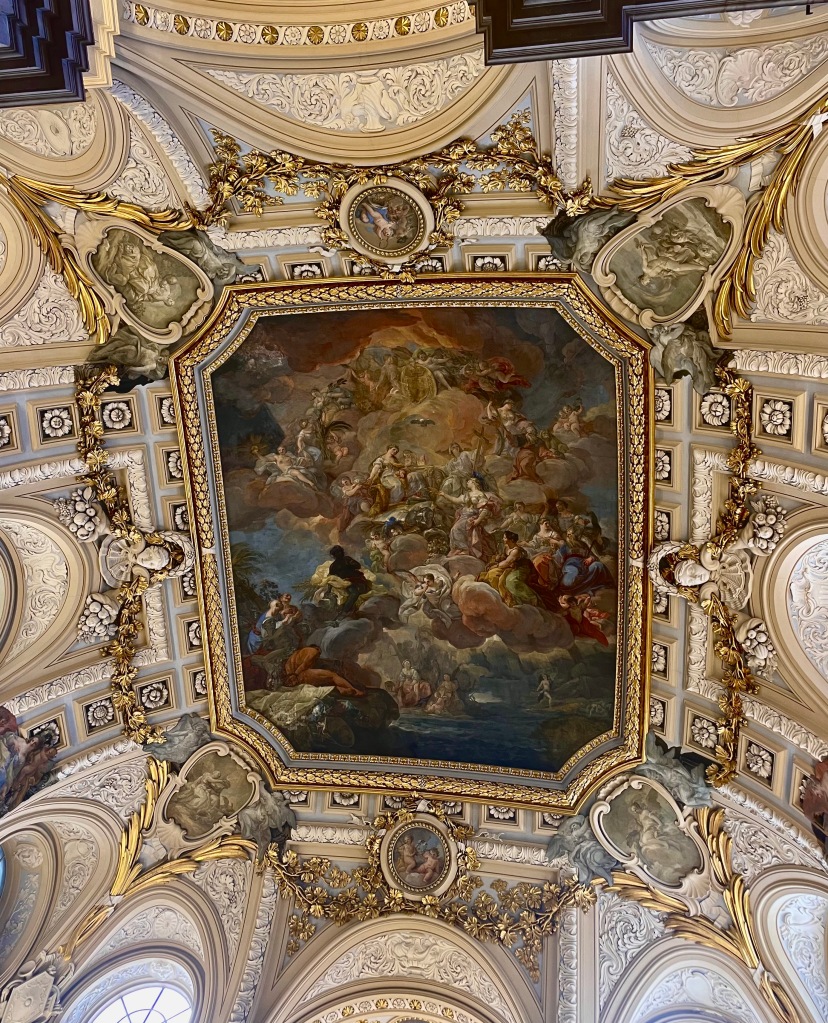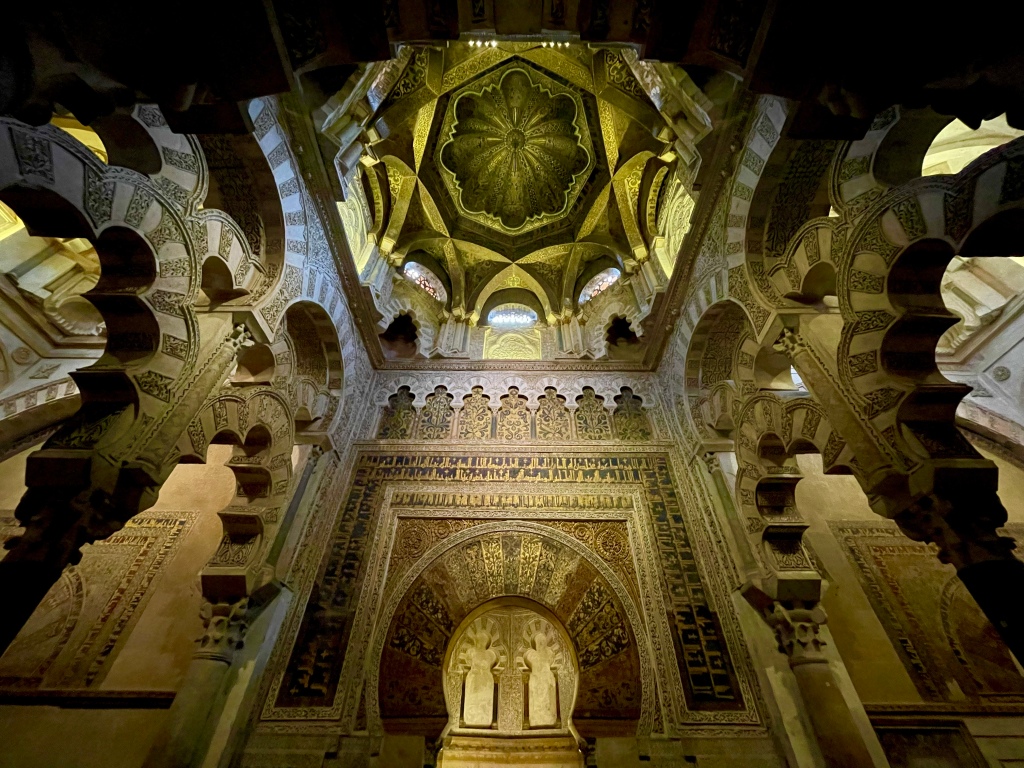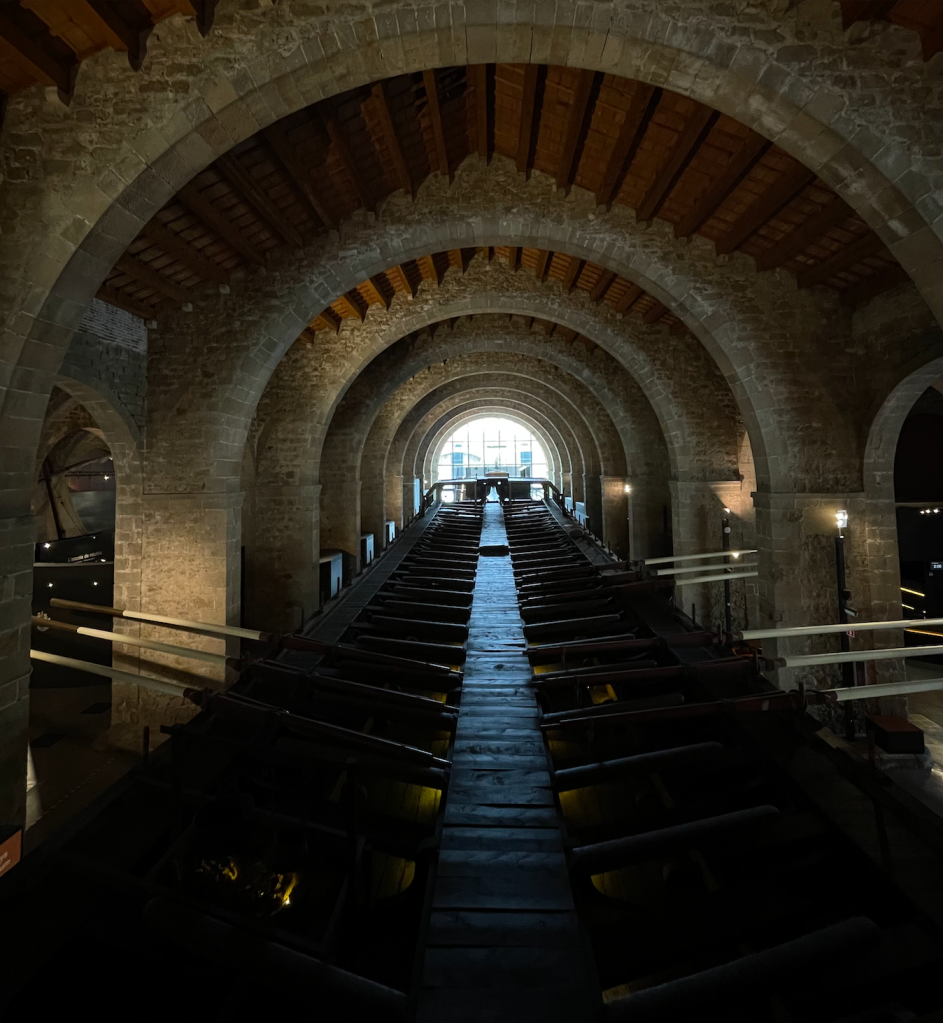
Isabella Garcia is a sophomore receiving a Bachelors of Science in Biology on a Pre-PA track at Florida International University. She has a passion for being outdoors and exploring, mainly for the ocean and is a Cuban-American.
Madrid as Text

Palace Bought with Blood
by Isabella Garcia of FIU at Madrid, España, 14 June 2022
One of the most impressive status symbol monuments of Madrid is the Palacio Real. Walking into this decadent castle feels surreal when surrounded by extravagant fourteen carat gold plated ceilings, carefully crafted marble floors, and grand dining room to welcome world leaders. The fact that this was once a family’s palace for them to live in puts great emphasis on their role in society and how they were truly above all.
For a palace like this, pictures do it no justice when it comes to details in the minor things to the point that it becomes profligacy. The amount of money spent on this palace really hit me when our tour guide explained how the weather affects the decorations in the entire palace. In Madrid, there are extremely hot, dry summers with cold, bitter winters. When it comes to the intense winters, the whole palace gets redecorated with tapestries to keep the palace warmer. Once the winter rolls out, the palace is redecorated once again, now changing the warm tapestries for paintings to keep the rooms cooler.
The most mind blowing part of the palace for me wasn’t the actual building itself, but it was the effect of the Museum of the Americas when relating it to El Palacio Real. This insane amount of money was spilled into a building to solely show wealth and the origin of this all of it came from the abuse of the Americas. This museum encompassed how the Europeans viewed the natives of America as animalistic and inferior to them.
Toledo as Text

Photo taken by Isabella Garcia // CC 4.0
El Greco
by Isabella Garcia of FIU at Toledo, España, 15 June 2022
Coming from a small Greek school in Kendall that wants to spread their culture, El Greco was a prideful piece of their history, and Toledo has El Greco everywhere.
First, I’ve learned of the painting “The Burial of the Count of Orgaz” in the Iglesias de Santo Tomé throughout high school as being one of his most pristine paintings, and at the time, I didn’t see it. I thought it was overhyped and it looked like a painting that Velazquez or other prominent Spanish Renaissance painters could do, but in person, everything is so much grander. The detail from the feeling of the little boy looking at you to the reflection of St. Steven on the armor of the Count of Orgaz feels overwhelming in person in comparison to in a computer screen.
The most meaningful connection was with his painting of “The View of Toledo.” In my Greek Language class in High School, El Greco was a hot topic. When researching for presentations, I fell in love with the painting. Even though the actual painting isn’t in Spain, Toledo was the topic of the painting. El Greco portrayed Toledo as a perfect balance of dramatic, yet soothing city, with the dark shadows but vibrantly green trees. One of the aspects of the painting that caught my attention a lot was the fact that the clouds show an obvious spot of light shining over Toledo amongst all of the other dark clouds. The most stunning part of it all was that we got to be exactly where El Greco painted this painting. If I would’ve told 16 year old me that I would be seeing that exact view with my own two eyes, I wouldn’t have believed it.
Sevilla as Text

Photo taken by Isabella Garcia // CC 4.0
The Nature in Miami is Missing
by Isabella Garcia of FIU at Sevilla, España, 22 June 2022
Sevilla is a breath of fresh air in a country that’s non-stop.
Automatically, the most impressive thing of Sevilla has to be the Alcazar de Sevilla. Each corner that’s taken is a whole different combination of architecture and art, leading to one massively impressive palace. Unlike many of the Cathedrals seen around Spain, this Alcazar is different in the sense that it follows Muslim architecture closely and truly feels out of this world. When walking out into the gardens, the size just continues to get grander. To put it into perspective, there is a whole labyrinth the size of a soccer field in the backyard because why not. The landscape is impeccably kept with the species and styles changing every turn you take.
The Gardens of Alcazar, being astonishing, doesn’t outweigh the awe of El Parque de Maria Luisa and Plaza de España. Walking into the park, I assumed that it would be very similar to El Retiro in Madrid, which is incredible as it is to Americans because of the lack of emphasis on parks and outdoors in general in the United States. I was so taken back by the fact that a smaller city like Sevilla could have something as decadent as El Alcazar yet have something so humbling like El Parque de Maria Luisa. Exploring the park on an off day, we first stumbled upon fountains with so much peace and wildlife, and having the view of the towers shows a balance of humanity and nature. The most stunning part of the Plaza de España was the Flamenco show that just happened to be going on as we were walking without intent. It sounds dramatic to say but the clashing of the dance shoes onto that wooden platform really seemed to travel through my body to the point of getting goosebumps.
Cordoba as Text

Photo taken by Isabella Garcia // CC 4.0
Transformer Cathedral
by Isabella Garcia of FIU at Cordoba, España, 18 June 2022
Cordoba took me completely by surprise. It looked surprisingly Muslim yet Greek at the same time. The architecture and use of tiles shows the Islamic influence which is an absolute major role in the history of Cordoba.
An incredibly unique feature that this city has is the vast Mosque-Cathedral of Cordoba. As it’s seen as one of their highlights of the city and a main attraction, it didn’t sit well with me. I appreciate the architecture and acknowledge the fact that the history goes so far back and it’s a true representation of how its cities and rulers used to work, but it’s disrespectful in nature. This Mosque is absolutely massive standing about the size of 4 full soccer fields and was turned into a Cathedral in 1236 when Cordoba was overruled. Unlike many other scenarios in European history, the Mosque wasn’t torn down or built over but it was “refurbished and transformed.”
In the Mosque-Cathedral, one of the most strange rules that had me thinking was the fact that no one was allowed to even get close to the floor in order to take a picture in front of the Muslim alter. At first, this may not seem like a big deal at all and could be seen as a way to keep the traffic moving and keep anyone from getting harmed, but it means a lot more to the Muslims. To pray, they kneel down, and the fact that it’s that prohibited in the building seems like a slap in the face to the religion while they’re taking advantage of their architecture and art.
Barcelona as Text

Night of Fire
by Isabella Garcia of FIU at Barcelona, España, 23 June 2022
The first night in Barcelona, we were welcomed in typical Barcelona manner. Being the most vibrant and alive city that we visited together, the Festival of Sant Joan was a great introduction. This night is one of the major party nights in Barcelona which is a public holiday on the summer solstice. Researching this holiday before the night began was extremely interesting and rewarding when actually seeing it take place. The idea behind this old tradition is that they celebrate on the longest day of the year in order to honor the sun which is a symbol of wealth and strength. A major role of this holiday is also the fire, which symbolizes purity, which is also the reason that fires and torches are lit throughout the city. Known as the Night of Fire, the Spanish go all out for their celebration.
Sitting on the boardwalk watching the night light up with fireworks alongside classmates seemed really similar to the American traditions of lighting up thousands of fireworks for July 4th. It was amazing to me how the United States has their own tradition of the Fourth of July, that’s a huge deal, and no other country recognizes it, and it’s the same case in Barcelona with this night. This celebration is not recognized anywhere else in the world. Another thing that hit me while watching the fireworks is just how old these celebrations are. In comparison to the European countries, the United States is so young and the ideologies behind these celebrations date back to mythological eras.
Sitges as Text

Wealth to and from
by Isabella Garcia of FIU at Sitges, España, 26 June 2022
This day trip had to be, by far, the most mind blowing when it comes to the whole foundation of this course: Ida y Vuelta. Throughout the course, in Europe and in the little classroom in GC, the influence of Spain on the Americas and vice versa. Learning about the Deering brothers and their wealth on paper is immensely different than going in person. When visiting the Deering Estate and Vizcaya in Miami during the Spring semester, their wealth is extremely prominent with the attention to detail in everything from the architecture, to the gardens, and even the dredged out canal. The most amazing part of this is that not only did Charles Deering create a sweet escape in Miami, but he refurbished an absolute gem in Sitges, Spain that blew the Deering Estate out of the water.
This white, mediterranean dream was finished around the early 1900s, a little over a decade after the Deering estate. He transformed a hospital and a private residence into a home that is now known and preserved as El Museus de Sitges. The wild part of this museum is that you should be expected to be surprised with each different room. Passing through the “house,” each room is decorated completely differently with new paints and artworks in each of them.
The wealth in artwork alone portrayed in this Sitges mansion and the Cap Ferrat museum told you everything you needed to know about this family, having five picassos all displayed right next to each other in a small, quaint room. Seeing how the wealth translates from one continent all the way to the other is astonishing being that it was the early 1900s and travel wasn’t as easy and prominent as it is these days.








